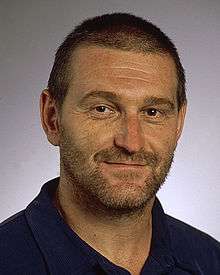Pavel A. Pevzner
| Pavel A. Pevzner | |
|---|---|
 Pavel Pevzner in 2011 | |
| Fields |
Bioinformatics, Computational biology Systems biology |
| Institutions |
University of Southern California Pennsylvania State University University of California, San Diego |
| Alma mater | Moscow Institute of Physics and Technology |
| Thesis | (1988) |
| Academic advisors | Michael Waterman |
| Doctoral students | Max Alekseyev, Vineet Bafna, Nuno Bandeira, Guillaume Bourque, Mark Chaisson, Phillip Compeau, Nitin Gupta, Sridhar Hannenhalli, Earl Hubbell, Neil Jones, Qian Peng, Son Pham, Sing-Hoi Sze, Degui Zhi[1] |
| Notable awards | ACM Fellow |
|
Website cseweb | |
Pavel A. Pevzner (Russian: Павел Аркадьевич Певзнер) is the Ronald R. Taylor Professor of Computer Science and Director of the NIH Center for Computational Mass Spectrometry at University of California, San Diego.[2][3] He serves on the Editorial Board of PLoS Computational Biology and he is a member of the Genome Institute of Singapore scientific advisory board.[4]
Research
Pevzner is interested in new approaches to teaching computational molecular biology at both undergraduate and graduate level,[5][6] serving as a founding instructor for the Bioinformatics Specialization on Coursera[7] and having written several books on Bioinformatics and Computational Biology.[3][8][9][10]
Education
Pevzner received his Ph.D. in Mathematics and Physics from the Moscow Institute of Physics and Technology while working for Russian Research Institute for Genetics and Selection of Industrial Microorganisms (NII Genetika). In 1990, he joined Michael Waterman's laboratory at the Department of Mathematics at the University of Southern California for two years as a postdoctoral research associate.
Career
In 1992, Pevzner took a position of an Associate Professor at the Pennsylvania State University.
In 1995, Pevzner moved back to the University of Southern California as a Professor of Mathematics, Computer Science, and Molecular Biology. Since 2000, he has been the Ronald R. Taylor Professor of Computer Science at the University of California, San Diego and he is the Director of the NIH Center for Computational Mass Spectrometry.
Books
- Computational Molecular Biology, MIT Press, 2000
- An Introduction to Bioinformatics Algorithms, MIT Press, 2004 (co-authored with Neil Jones)
- Bioinformatics for Biologists, Cambridge University Press, 2011 (co-edited with Ron Shamir)
- Bioinformatics Algorithms: An Active Learning Approach', Active Learning Publishers, 2014 (co-authored with Phillip Compeau)
Awards
- NSF Young Investigator Award (1994, 1995)[11][12]
- HHMI Research Professor award (2006) from the Howard Hughes Medical Institute.[13]
- UCSD Chancellor Associates Award for Excellence in Research (2007).[14]
- ACM Fellow (2010), for "contribution to algorithms for genome rearrangements, DNA sequencing, and proteomics".[15][16]
- Honoris causa degree (2011) from Simon Fraser University.[17]
References
- ↑ Pavel A. Pevzner at the Mathematics Genealogy Project
- ↑ Pavel Pevzner's faculty profile, Departments of Computer Science and Engineering, University of California at San Diego.
- 1 2 HHMI Scientist bio, Howard Hughes Medical Institute. Accessed June 13, 2011
- ↑ Scientific Advisory Board, Genome Institute of Singapore.
- ↑ Pevzner, P.; Shamir, R. (2009). "Computing Has Changed Biology--Biology Education Must Catch Up". Science. 325 (5940): 541–542. doi:10.1126/science.1173876. PMID 19644094.
- ↑ Pevzner, P. A. (2004). "Educating biologists in the 21st century: Bioinformatics scientists versus bioinformatics technicians". Bioinformatics. 20 (14): 2159–2161. doi:10.1093/bioinformatics/bth217. PMID 15073013.
- ↑ https://www.coursera.org/specializations/bioinformatics
- ↑ Pevzner, Pavel; Jones, Neil D. (2004). An introduction to bioinformatics algorithms. Cambridge, Mass: MIT Press. ISBN 0-262-10106-8.
- ↑ Pevzner, Pavel (2000). Computational molecular biology: an algorithmic approach. Cambridge, Mass: MIT Press. ISBN 0-262-16197-4.
- ↑ Pevzner's publications in Google Scholar.
- ↑ NSF Young Investigator: Computational Molecular Biology Award 1994
- ↑ NSF Young Investigator: Computational Molecular Biology Award 1995
- ↑ HHMI Names 20 New Million-Dollar Professors: Top Research Scientists Tapped for their Teaching Talent, Howard Hughes Medical Institute news-release, April 5, 2006. Accessed June 13, 2011.
- ↑ UCSD Faculty Excellence Awards 2007 — Pavel Pevzner
- ↑ ACM Fellow profile, Association for Computing Machinery. Accessed June 13, 2011
- ↑ TWO UC SAN DIEGO COMPUTER SCIENTISTS RECOGNIZED FOR CONTRIBUTIONS IN COMPUTER SYSTEMS SECURITY, BIOINFORMATICS, University of California, San Diego news release, December 8, 2010. Accessed June 13, 2011.
- ↑ Honorary Degree Citations: The degree of Doctor of Science, honoris causa, conferred on Dr. Pevzner, Friday, June 17, 2011.